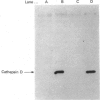Abstract
Acute starvation of the wild-type of the nematode Caenorhabditis elegans depresses the level of cathepsin D by 65% within 4-8 h and the level of the thiol cathepsins Ce1 and Ce2 to about the same extent after 24 h. There is no parallel loss of lysosomal beta-glucosidase or beta-hexosaminidase activities. In strains which are chronically starved as a result of mutations which compromise feeding behaviour (unc-52) or nutrient uptake into the intestinal cells (daf-4), cathepsin D levels are decreased to about 15% of the level in fully fed wild-type animals. We suggest that the decline in the cathepsin D level results from autodigestion when alternative protein substrates are depleted in the lysosomes.
Full text
PDF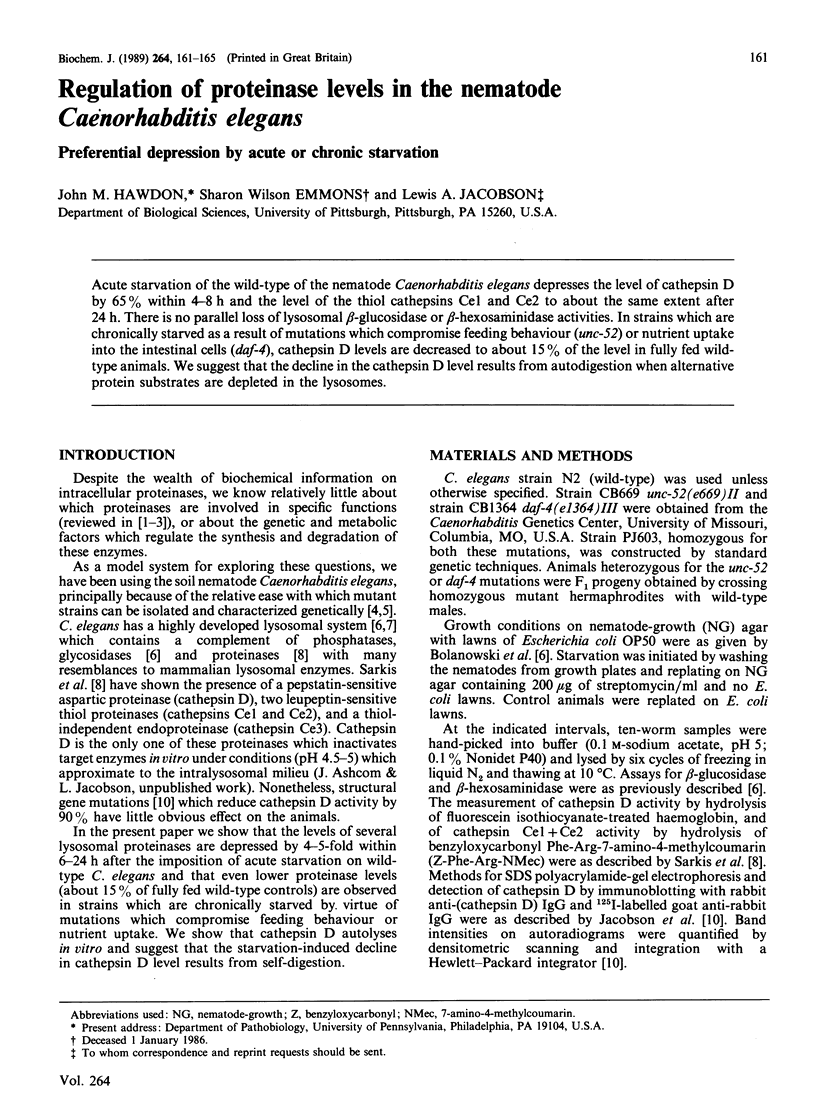
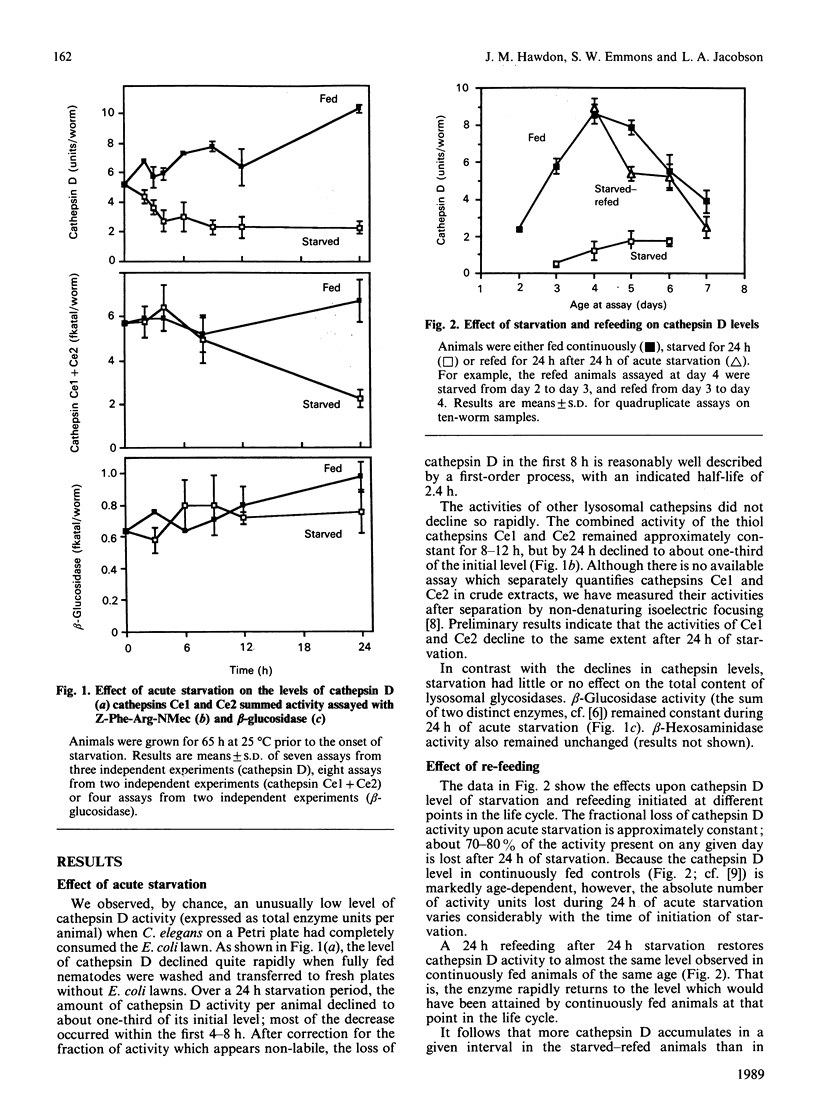
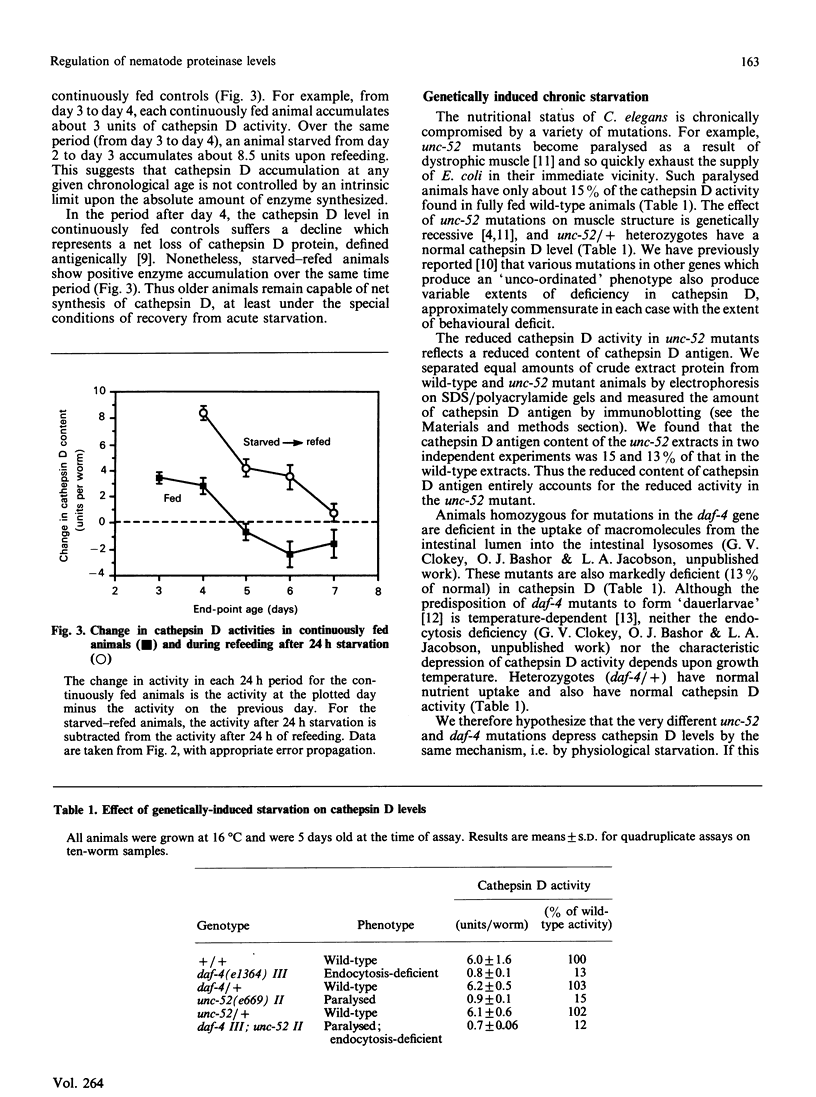
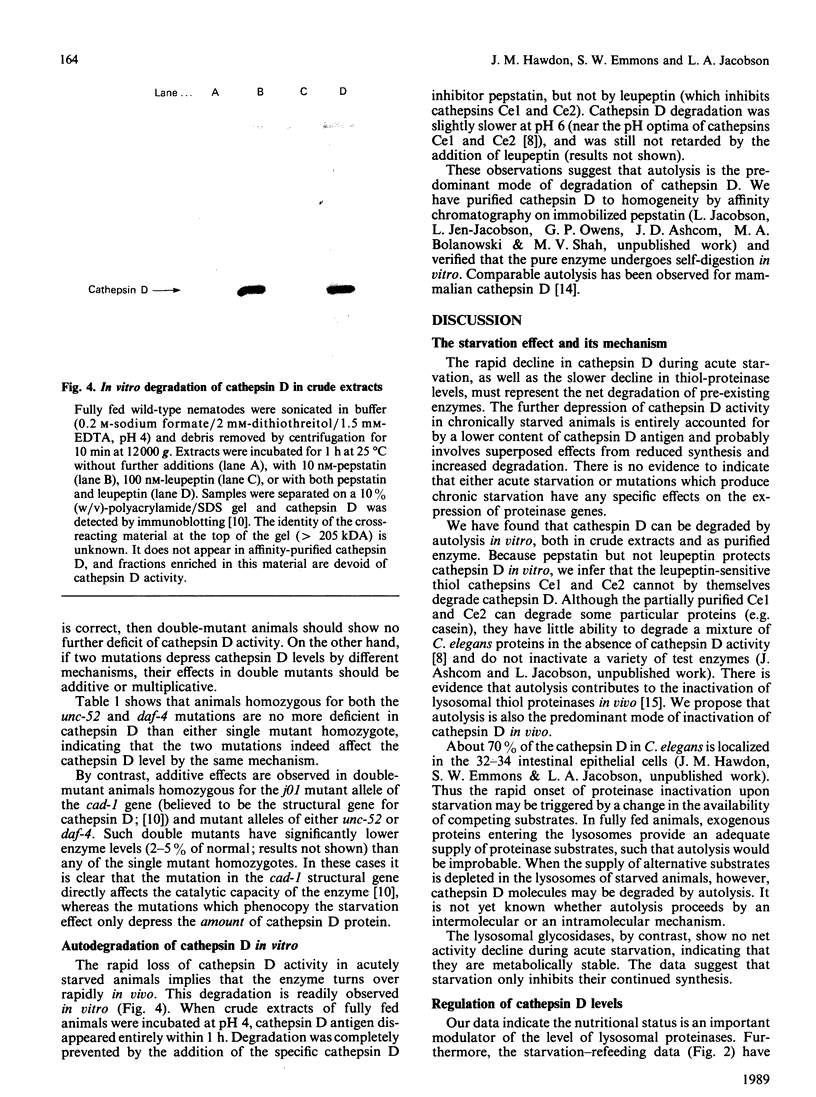
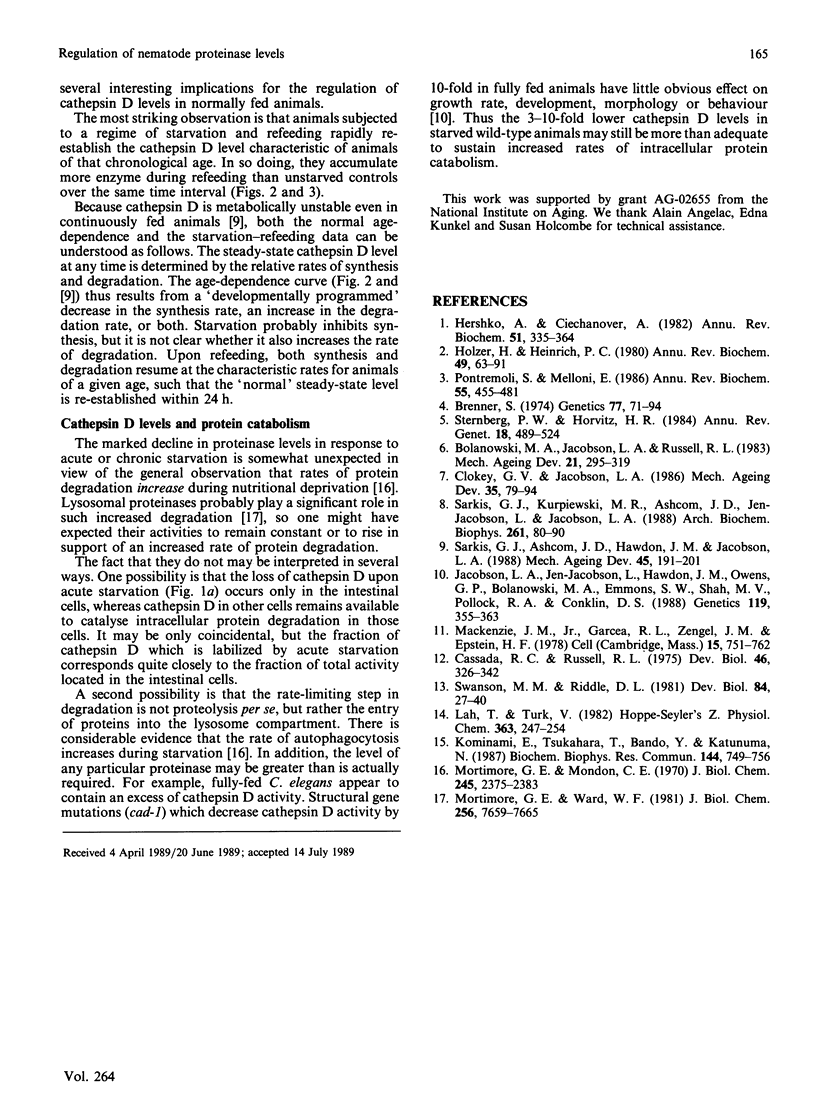
Images in this article
Selected References
These references are in PubMed. This may not be the complete list of references from this article.
- Bolanowski M. A., Jacobson L. A., Russell R. L. Quantitative measures of aging in the nematode Caenorhabditis elegans: II. Lysosomal hydrolases as markers of senescence. Mech Ageing Dev. 1983 Mar-Apr;21(3-4):295–319. doi: 10.1016/0047-6374(83)90048-9. [DOI] [PubMed] [Google Scholar]
- Brenner S. The genetics of Caenorhabditis elegans. Genetics. 1974 May;77(1):71–94. doi: 10.1093/genetics/77.1.71. [DOI] [PMC free article] [PubMed] [Google Scholar]
- Cassada R. C., Russell R. L. The dauerlarva, a post-embryonic developmental variant of the nematode Caenorhabditis elegans. Dev Biol. 1975 Oct;46(2):326–342. doi: 10.1016/0012-1606(75)90109-8. [DOI] [PubMed] [Google Scholar]
- Clokey G. V., Jacobson L. A. The autofluorescent "lipofuscin granules" in the intestinal cells of Caenorhabditis elegans are secondary lysosomes. Mech Ageing Dev. 1986 Jun;35(1):79–94. doi: 10.1016/0047-6374(86)90068-0. [DOI] [PubMed] [Google Scholar]
- Hershko A., Ciechanover A. Mechanisms of intracellular protein breakdown. Annu Rev Biochem. 1982;51:335–364. doi: 10.1146/annurev.bi.51.070182.002003. [DOI] [PubMed] [Google Scholar]
- Holzer H., Heinrich P. C. Control of proteolysis. Annu Rev Biochem. 1980;49:63–91. doi: 10.1146/annurev.bi.49.070180.000431. [DOI] [PubMed] [Google Scholar]
- Jacobson L. A., Jen-Jacobson L., Hawdon J. M., Owens G. P., Bolanowski M. A., Emmons S. W., Shah M. V., Pollock R. A., Conklin D. S. Identification of a putative structural gene for cathepsin D in Caenorhabditis elegans. Genetics. 1988 Jun;119(2):355–363. doi: 10.1093/genetics/119.2.355. [DOI] [PMC free article] [PubMed] [Google Scholar]
- Kominami E., Tsukahara T., Bando Y., Katunuma N. Autodegradation of lysosomal cysteine proteinases. Biochem Biophys Res Commun. 1987 Apr 29;144(2):749–756. doi: 10.1016/s0006-291x(87)80028-1. [DOI] [PubMed] [Google Scholar]
- Lah T., Turk V. Autolysis studies of cathepsin D. Hoppe Seylers Z Physiol Chem. 1982 Mar;363(3):247–254. doi: 10.1515/bchm2.1982.363.1.247. [DOI] [PubMed] [Google Scholar]
- Mackenzie J. M., Jr, Garcea R. L., Zengel J. M., Epstein H. F. Muscle development in Caenorhabditis elegans: mutants exhibiting retarded sarcomere construction. Cell. 1978 Nov;15(3):751–762. doi: 10.1016/0092-8674(78)90261-1. [DOI] [PubMed] [Google Scholar]
- Mortimore G. E., Mondon C. E. Inhibition by insulin of valine turnover in liver. Evidence for a general control of proteolysis. J Biol Chem. 1970 May 10;245(9):2375–2383. [PubMed] [Google Scholar]
- Mortimore G. E., Ward W. F. Internalization of cytoplasmic protein by hepatic lysosomes in basal and deprivation-induced proteolytic states. J Biol Chem. 1981 Jul 25;256(14):7659–7665. [PubMed] [Google Scholar]
- Pontremoli S., Melloni E. Extralysosomal protein degradation. Annu Rev Biochem. 1986;55:455–481. doi: 10.1146/annurev.bi.55.070186.002323. [DOI] [PubMed] [Google Scholar]
- Sarkis G. J., Ashcom J. D., Hawdon J. M., Jacobson L. A. Decline in protease activities with age in the nematode Caenorhabditis elegans. Mech Ageing Dev. 1988 Nov 30;45(3):191–201. doi: 10.1016/0047-6374(88)90001-2. [DOI] [PubMed] [Google Scholar]
- Sarkis G. J., Kurpiewski M. R., Ashcom J. D., Jen-Jacobson L., Jacobson L. A. Proteases of the nematode Caenorhabditis elegans. Arch Biochem Biophys. 1988 Feb 15;261(1):80–90. doi: 10.1016/0003-9861(88)90106-3. [DOI] [PubMed] [Google Scholar]
- Sternberg P. W., Horvitz H. R. The genetic control of cell lineage during nematode development. Annu Rev Genet. 1984;18:489–524. doi: 10.1146/annurev.ge.18.120184.002421. [DOI] [PubMed] [Google Scholar]
- Swanson M. M., Riddle D. L. Critical periods in the development of the Caenorhabditis elegans dauer larva. Dev Biol. 1981 May;84(1):27–40. doi: 10.1016/0012-1606(81)90367-5. [DOI] [PubMed] [Google Scholar]



